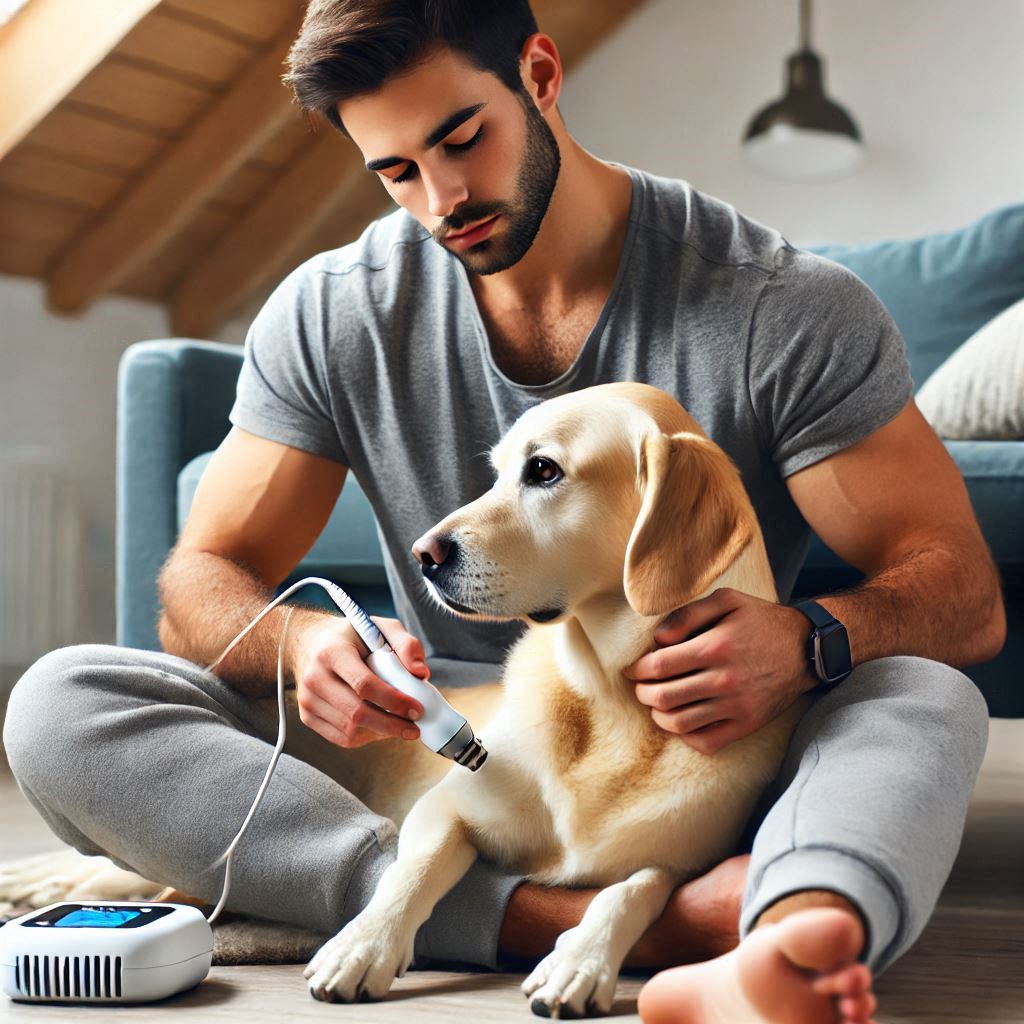PEMF Therapy for Pets
When I first encountered Pulsed Electromagnetic Field (PEMF) therapy for pets, I was intrigued but skeptical. Could electromagnetic fields really make a significant difference in animal health?
After extensive research and conversations with veterinarians who use this technology, I’m convinced that PEMF therapy is a game-changer in veterinary medicine.
The Science Behind PEMF Therapy
PEMF therapy works by emitting low-frequency electromagnetic waves that penetrate deep into an animal’s tissues. These waves interact with the body at a cellular level, stimulating various biological processes that promote healing and overall wellness.
Cellular Regeneration and Repair
One of the primary mechanisms of PEMF therapy is it’s ability to enhance cellular regeneration. The electromagnetic fields stimulate the production of ATP (adenosine triphosphate), the energy currency of cells.
With increased ATP, cells function more efficiently, leading to faster repair and regeneration of damaged tissues.
This process is particularly beneficial for pets recovering from injuries or surgeries. The enhanced cellular activity can speed up healing times and reduce the risk of complications.
For older pets or those with chronic conditions, PEMF therapy can help maintain cellular health and slow down degenerative processes.
Improved Circulation and Oxygenation
PEMF therapy significantly improves blood flow and oxygenation throughout the body. The electromagnetic fields cause a slight dilation of blood vessels, allowing for better circulation even in areas with poor blood flow.
This enhanced circulation has far-reaching effects, from reducing inflammation to accelerating wound healing.
For pets with circulatory issues, such as those with diabetes or peripheral vascular disease, PEMF therapy can be a valuable tool in managing their condition. The improved blood flow can help prevent complications and improve overall quality of life.
Pain Reduction and Anti-Inflammatory Effects
Many pet owners turn to PEMF therapy for it’s pain-relieving properties. The electromagnetic fields help reduce pain signals and promote the release of endorphins, the body’s natural painkillers.
This makes PEMF therapy an excellent option for pets suffering from acute or chronic pain conditions.
Additionally, PEMF therapy has potent anti-inflammatory effects. It can help reduce swelling and inflammation in various tissues, providing relief for pets with conditions like arthritis, inflammatory bowel disease, or skin allergies.
The anti-inflammatory properties of PEMF therapy make it a valuable choice or complement to traditional medications, potentially reducing the need for long-term use of NSAIDs (non-steroidal anti-inflammatory drugs) or steroids.
Practical Applications of PEMF Therapy for Pets
The versatility of PEMF therapy is one of it’s most impressive aspects. From chronic conditions to acute injuries, this treatment modality has shown promise in a wide range of veterinary applications.
Arthritis and Joint Health
One of the most well-studied applications of PEMF therapy in pets is for the treatment of arthritis and other joint issues. A 2003 study published in the Journal of the American Animal Hospital Association found that PEMF therapy significantly improved clinical signs of osteoarthritis in dogs.
Pet owners reported increased mobility and decreased pain in their arthritic companions after regular PEMF treatments.
For pets with arthritis, PEMF therapy can:
- Reduce joint pain and stiffness
- Improve mobility and range of motion
- Decrease inflammation in affected joints
- Slow down the progression of cartilage degeneration
Many pet owners have reported that their arthritic dogs or cats become more active and playful after starting PEMF therapy. This improvement in quality of life is one of the most rewarding aspects of using this treatment modality.
Wound Healing and Post-Surgical Recovery
PEMF therapy has shown remarkable effects on wound healing in animals. A 2015 study at Mississippi State University revealed that PEMF therapy accelerated wound closure in dogs.
This has significant implications for pets recovering from injuries or surgeries, potentially reducing healing time and minimizing complications.
The benefits of PEMF therapy for wound healing include:
- Accelerated tissue repair
- Reduced risk of infection
- Decreased inflammation and swelling
- Improved circulation to the wound site
Veterinarians often recommend PEMF therapy as part of a comprehensive post-surgical care plan. It can help pets recover more quickly and comfortably from procedures ranging from routine spays and neuters to more complex orthopedic surgeries.
Neurological Conditions
Emerging research suggests that PEMF therapy may be useful for pets with neurological conditions. Some veterinarians have reported improvements in pets with conditions like intervertebral disc disease (IVDD) and even epilepsy after incorporating PEMF therapy into their treatment plans.
For pets with neurological issues, PEMF therapy may:
- Reduce inflammation in the nervous system
- Promote nerve regeneration
- Improve blood flow to the brain and spinal cord
- Help manage seizure activity in some cases
While more research is needed in this area, the potential of PEMF therapy for neurological conditions is exciting. It offers hope for pets with conditions that can be challenging to treat with conventional methods alone.
Behavioral Issues and Anxiety
While more research is needed in this area, some pet owners and veterinarians have reported improvements in pet behavior and reduced anxiety with regular PEMF treatments. The therapy’s ability to promote relaxation and balance in the body may contribute to these effects.
PEMF therapy may help pets with:
- General anxiety or stress
- Noise phobias (e.g., thunderstorm anxiety)
- Separation anxiety
- Aggression or hyperactivity
The calming effects of PEMF therapy can be particularly beneficial for rescue animals or pets with a history of trauma. It may help them adjust to new environments and form stronger bonds with us.
Implementing PEMF Therapy: A Step-by-Step Guide
If you’re considering PEMF therapy for your pet, here’s a detailed guide to getting started:
1. Consult with a Veterinarian
Always start by discussing PEMF therapy with a veterinarian who is knowledgeable about the treatment. They can help decide if it’s suitable for your pet’s specific condition and how it might fit into their overall treatment plan.
During this consultation:
- Provide a detailed medical history of your pet
- Discuss any current medications or treatments
- Ask about potential interactions or contraindications
- Inquire about the expected benefits and timeline for improvement
2. Choose a Device
There are various PEMF devices available for veterinary use. Your vet may have recommendations, or you might consider renting or purchasing a device for home use.
When selecting a device, consider:
- The size and portability of the unit
- The range of frequencies and intensities available
- Ease of use and programming options
- Cost and warranty information
- Reviews from other pet owners or veterinary professionals
3. Determine the Treatment Protocol
The frequency and duration of PEMF treatments can vary depending on your pet’s condition. Your vet will help establish a suitable protocol.
A typical treatment plan might include:
- Initial frequency: Daily treatments for acute conditions, or 2-3 times per week for chronic issues
- Duration: Sessions lasting 15-30 minutes, depending on the condition and your pet’s tolerance
- Intensity: Starting at a lower setting and gradually increasing as needed
- Reassessment: Regular check-ins with your vet to adjust the protocol based on your pet’s response
4. Prepare Your Pet
Most animals tolerate PEMF therapy well, but it’s important to create a calm environment for treatments. Use treats or positive reinforcement to help your pet associate the therapy with a positive experience.
Tips for preparing your pet:
- Choose a quiet, comfortable space for treatments
- Introduce the PEMF device gradually, allowing your pet to sniff and investigate it
- Use a favorite bed or blanket to create a cozy treatment area
- Have treats or toys on hand to reward calm behavior
5. Administer Treatments
Follow the prescribed protocol, typically placing the PEMF device on or near the affected area of your pet’s body for the specified duration.
During treatments:
- Ensure your pet is comfortable and relaxed
- Monitor their behavior for any signs of distress
- Stay nearby to provide reassurance if needed
- Use the time to bond with them, offering gentle petting or massage
6. Monitor Progress
Keep track of any changes in your pet’s condition, behavior, or energy levels. Regular check-ins with your vet can help adjust the treatment plan as needed.
Consider keeping a journal to record:
- Treatment dates and durations
- Any changes in symptoms or behavior
- Energy levels and activity patterns
- Medication usage (if applicable)
- Overall quality of life improvements
7. Be Consistent
Like many therapies, consistency is key with PEMF treatments. Stick to the recommended schedule for the best results.
To maintain consistency:
- Set reminders on your phone or calendar
- Incorporate treatments into your daily routine
- Enlist family members to help with treatments if needed
- Consider using a treatment log to track sessions
Potential Challenges and How to Overcome Them
While PEMF therapy is generally well-tolerated, there are some challenges you might encounter:
Pet Resistance
Some pets may be initially wary of the PEMF device. Gradual introduction and positive reinforcement can help overcome this.
Strategies to help resistant pets:
- Start with very short sessions, even just a few minutes
- Use high-value treats to create positive associations
- Try placing the PEMF device near your pet during relaxation times, without turning it on
- Consider using a lower intensity setting initially
- Gradually increase session duration as your pet becomes more comfortable
Determining Optimal Settings
Finding the right frequency and intensity settings for your pet’s specific condition can take some trial and error. Work closely with your veterinarian to adjust settings based on your pet’s response to treatment.
Tips for optimizing settings:
- Start with lower intensity settings and gradually increase
- Pay attention to your pet’s body language during treatments
- Keep detailed notes on which settings seem most effective
- Be patient – it may take several sessions to find the ideal combination
Consistency in Home Treatments
If you’re using a home PEMF device, maintaining a consistent treatment schedule can be challenging. Set reminders and try to incorporate treatments into your daily routine to confirm regularity.
Ideas for maintaining consistency:
- Schedule treatments at the same time each day
- Combine PEMF therapy with other daily activities, like grooming or feeding
- Use a wall calendar or app to track treatments
- Consider enlisting family members to help with treatments
Adapting PEMF Therapy for Different Pets
While the basic principles of PEMF therapy stay the same across species, there are some considerations for different types of pets:
Dogs
Dogs often respond well to PEMF therapy, particularly for joint issues and post-surgical recovery. Larger breeds may need higher intensity settings or longer treatment durations.
Considerations for dogs:
- Adjust treatment area size based on the dog’s body size
- Be mindful of thick fur, which may affect the penetration of the electromagnetic field
- Consider using PEMF therapy in conjunction with physical therapy for orthopedic conditions
Cats
Cats can be more sensitive to electromagnetic fields, so starting with lower intensity settings is often recommended. PEMF therapy can be particularly useful for feline arthritis and chronic pain conditions.
Tips for treating cats:
- Use shorter treatment durations initially
- Choose a quiet, enclosed space for treatments to minimize distractions
- Consider using pheromone sprays or diffusers to create a calming environment
Horses
Equine PEMF therapy has gained popularity in recent years, especially for performance horses. Larger PEMF devices or mats are often used to accommodate the size of horses.
Equine PEMF considerations:
- Use larger, more powerful devices designed specifically for horses
- Focus on common problem areas like legs, back, and neck
- Incorporate PEMF therapy into pre- and post-performance routines
- Be mindful of metal shoes, which may affect the electromagnetic field
Small Pets
For smaller pets like rabbits or guinea pigs, very low intensity settings and shorter treatment durations are typically used. Always ask with an exotic pet veterinarian before starting PEMF therapy for these animals.
Guidelines for small pets:
- Use the lowest intensity settings available
- Keep treatment sessions very short, often just a few minutes
- Monitor closely for any signs of stress or discomfort
- Consider using a smaller, more targeted PEMF device
Combining PEMF with Other Therapies
PEMF therapy can be an excellent complement to other treatment modalities. Many veterinarians find that combining PEMF with therapies like acupuncture, massage, or physical therapy can enhance overall outcomes for pets.
Potential combinations:
- PEMF and acupuncture: Can enhance pain relief and promote healing
- PEMF and massage: May improve circulation and reduce muscle tension
- PEMF and physical therapy: Can support muscle recovery and joint mobility
- PEMF and hydrotherapy: May enhance the benefits of water-based exercises
When combining therapies, it’s crucial to work closely with your veterinarian to create a comprehensive treatment plan that addresses your pet’s specific needs.
Safety Considerations and Contraindications
While PEMF therapy is generally considered safe for most pets, there are some situations where caution is advised:
Pregnancy
PEMF therapy is typically not recommended for pregnant animals, as the effects on fetal development are not well-studied.
Active Infections
In cases of active bacterial infections, PEMF therapy should be used with caution, as it may potentially stimulate bacterial growth.
Bleeding Disorders
Pets with bleeding disorders or those on blood-thinning medications should be closely monitored when using PEMF therapy, as it can affect blood flow.
Implanted Electronic Devices
If your pet has an implanted electronic device, such as a pacemaker, PEMF therapy may interfere with it’s function and should be avoided.
Cancer
While some studies suggest PEMF therapy may have anti-cancer properties, it’s use in pets with active cancer should be carefully evaluated by an oncologist.
Always ask with your veterinarian before starting PEMF therapy, especially if your pet has any pre-existing health conditions or is taking medications.
The Future of PEMF Therapy in Veterinary Medicine
As research in this field continues to grow, we can expect to see even more applications for PEMF therapy in veterinary medicine. Some exciting areas of future research include:
- The use of PEMF therapy in managing cognitive decline in senior pets
- Potential applications for autoimmune disorders in animals
- Combining PEMF therapy with regenerative medicine techniques
- Development of more specialized PEMF devices for different species and conditions
As a pet owner, staying informed about these developments can help you make the best decisions for your dog’s health and well-being.
Frequently Asked Questions
What is PEMF therapy for pets?
PEMF therapy for pets uses low-frequency electromagnetic fields to stimulate cellular repair and promote healing in animals. It’s a non-invasive treatment that can help with various conditions, including pain, inflammation, and tissue regeneration.
How does PEMF therapy work on animals?
PEMF therapy works by emitting electromagnetic waves that penetrate the animal’s tissues. These waves interact with cells, stimulating ATP production, improving circulation, and promoting various healing processes at the cellular level.
Is PEMF therapy safe for dogs and cats?
PEMF therapy is generally considered safe for dogs and cats when used properly. However, it’s essential to ask with a veterinarian before starting treatment, especially if your pet has any pre-existing health conditions.
Can PEMF therapy help with arthritis in older pets?
Yes, PEMF therapy has shown promising results in managing arthritis in older pets. It can help reduce pain and inflammation, improve joint mobility, and enhance overall quality of life for pets with arthritis.
How long does a typical PEMF therapy session last for pets?
A typical PEMF therapy session for pets usually lasts between 15 to 30 minutes, depending on the condition being treated and the animal’s needs. Your veterinarian will recommend a suitable treatment duration.
Are there any side effects of PEMF therapy for animals?
Side effects of PEMF therapy in animals are rare when used correctly. Some pets may experience mild fatigue or increased thirst after treatment.
If you notice any unusual reactions, ask your veterinarian.
Can PEMF therapy be used for post-surgical recovery in pets?
Yes, PEMF therapy can be beneficial for post-surgical recovery in pets. It can help reduce pain and inflammation, speed up wound healing, and promote faster overall recovery.
How often should PEMF therapy be administered to pets?
The frequency of PEMF therapy sessions depends on the pet’s condition and treatment goals. Some pets may benefit from daily treatments, while others might need sessions 2-3 times per week.
Your veterinarian will create a tailored treatment plan.
Can PEMF therapy help with anxiety in pets?
Some pet owners and veterinarians have reported improvements in pet anxiety with PEMF therapy. While more research is needed, the therapy’s ability to promote relaxation may help manage stress and anxiety in some animals.
Is PEMF therapy covered by pet insurance?
Coverage for PEMF therapy varies among pet insurance providers. Some may cover it as part of choice or complementary therapies, while others may not.
Check with your specific insurance provider for details on coverage.
Key Takeaways
- PEMF therapy is a non-invasive treatment that uses electromagnetic fields to promote healing and wellness in pets.
- It has shown promise in treating a wide range of conditions, including arthritis, wound healing, and neurological issues.
- PEMF therapy works at the cellular level, enhancing ATP production, improving circulation, and reducing inflammation.
- Consistency and proper protocol are crucial for achieving optimal results with PEMF therapy.
- While generally safe, PEMF therapy should always be administered under veterinary guidance to confirm suitable use for each pet.


